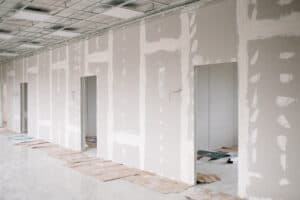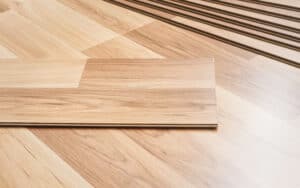
Plywood has several applications for its use.
Not all plywood shares the same strength.
Knowing which to use for your project can help prevent problems with integrity.
Here’s everything you need to know about plywood and its role in supporting structures.
How Much Weight Can Plywood Support?

Plywood with a 3/4-inch thickness made of fir can support 50 pounds.
Plywood with a 1/4-inch thickness made of fir can only support five pounds.
As the thickness of the plywood increases, the ability to support more weight also increases.
The type of wood that’s used, the grade, the plywood rating, and the pattern used to create the plywood all factor into its durability and strength.
Factors That Influence The Strength Of Plywood

There are a few factors that can influence how strong plywood is.
Consider these factors below when choosing the plywood you need for your project.
1. Type Of Wood Used

The type of wood that makes up plywood is important.
The most common type of wood is softwood.
This refers to conifers like pine and fir trees.
Hardwood is sometimes used as well.
When compared on their own, hardwood is stronger than softwood.
However, softwood becomes stronger than hardwood after manufacturing.
2. Layers

The more layers that plywood has, the stronger it is.
Wood chips make up plywood.
They’re arranged in a criss-cross pattern.
Some make up a perpendicular pattern while others use a pattern of rotating degree turns.
The more wood chips plywood has, the stronger it becomes.
When choosing plywood for your project, you’ll want to use a sheet with more layers if you want durability.
3. Thickness

Thickness also plays a role in the strength of plywood.
It goes hand-in-hand with how many layers make up the plywood.
If it has several layers, then it’s going to be thick.
Thin pieces of plywood are better for cabinets and interior projects.
Thicker pieces of plywood are better for structural and load-bearing projects.
The thicker that plywood is, the better it can distribute the weight through its core.
4. Adhesives

Administering glue to the wood chips holds the plywood together.
There are several different types of adhesives and veneers from which to choose.
Not all give plywood a lot of strength.
Some may be waterproof, for example.
Those are stronger for outdoor projects.
Other types of adhesives may hold the wood chips better than others.
These create durable and solid pieces of plywood.
Knowing the quality of the adhesive or veneer in the plywood is essential for choosing a strong one.
5. Flexibility

It may be surprising to know that some types of plywood are flexible.
Its flexibility makes it stronger and able to carry more weight.
Flexible plywood makes up the structural integrity of permanent structures like homes.
It’s attached to 2x4s, then covered.
Its flexibility makes a home stronger than it would be without it.
How Much Weight Does Plywood Support Based On Thickness?

Under a controlled environment, you can determine how much weight plywood can support.
It’s based on its thickness.
A good estimate follows these parameters.
Each plywood has a span of three feet.
Each thickness layer uses the lowest ply available.
Both ends of the plywood are fixed.
The wood grain runs parallel to the direction the plywood is being used.
With these variables in place, it’s possible to understand how much weight plywood can support based on its thickness.
The list below demonstrates a thickness-to-pounds-per-square-foot ratio.
- 3-Ply 3/8” Thickness: 22 psf
- 3-Ply 1/2” Thickness: 35 psf
- 4-Ply 3/4” Thickness: 80 psf
- 5-Ply 1” Thickness: 164 psf
With this data in mind, it’s clear to see that as thickness increases, the amount of weight that can be supported also increases.
What Are The Different Types Of Plywood And Their Benefits?

The type of plywood also indicates its strength.
Certain types can hold more weight than others.
The main types of plywood include the following:
- Sanded plywood
- Hardwood plywood
- Sheathing plywood
- Markerboard plywood
Let’s dig further into each of these to understand their benefits.
1. Sanded Plywood
Sanded plywood is most known for its high-quality finish.
It’s sanded and smooth.
The wood chips are dense and held together tightly.
This gives it a high strength-to-weight ratio.
This type of plywood is common in the construction of cabinets, shelving, and even some structural applications.
It can hold a lot of weight.
You can also paint its smooth surface.
2. Hardwood Plywood
Hardwood refers to wood that’s gathered from oak, birch, maple, and other similar trees.
In their construction, they’re glued at right angles to one another.
This pattern gives the plywood considerable strength.
The plywood is also heavier than other types of plywood.
Due to its weight and strength, hardwood plywood is often used in furniture construction.
It’s best for load-bearing frames.
3. Sheathing Plywood
This type of plywood is specifically useful for buildings.
It’s often used to frame structures, give support to bracing panels, and in flooring projects.
It’s not finished which means it’s not smooth or particularly pretty.
It isn’t designed for appearances, nor is it weather-resistant.
Covering sheathing plywood is essential for its long-term durability.
If it becomes wet, then it could lose its strength.
Other materials can cover it to preserve its durability.
4. Markerboard Plywood

Markerboard plywood is surprisingly strong.
It’s made up of panels of plywood.
Panels are common in DIY projects.
They come in various thicknesses and sizes.
Markerboard plywood uses a writing surface coating on top of the panels.
The coating allows the use of dry-erase markers on it.
While this type of plywood is strong, it’s also thin.
It can’t hold up that much weight.
How Ply Impacts Plywood Strength

The word ply in plywood refers to the amount of veneer in it. It’s always referred to in odd numbers.
The weakest plywood uses three-ply while specialty plywood uses seven-ply and greater.
Here’s how ply impacts plywood strength and its ability to carry weight.
1. Three-Ply
This is the most common type of plywood.
The veneer is two to three millimeters thick.
It’s most often found in cabinetry or indoor projects.
The use is decorative.
Since it has a thin veneer, three-ply plywood isn’t very strong.
It can’t hold up too much weight.
2. Five-Ply
Five-ply is the most versatile of plywood types.
It’s used in both indoor and outdoor applications.
Yet, it’s not ideal for structural framing.
The veneer has three to four millimeters of thickness.
Five-Ply can sometimes be waterproof.
It’s able to hold more weight than three-ply.
3. Multi-Ply
When the plywood has a ply rating greater than five-ply, it becomes known as multi-ply.
It may be seven-ply or even nine-ply.
Multi-ply is very strong.
It’s often used in roofing, framing, and in other structural projects.
Because it has a thick coating of veneer, it can support a lot of weight.
How Plywood Ratings Impact Strength Ratings

Knowing the plywood’s rating is important to find the right piece for your needs.
Each rating indicates how the plywood is best used.
Understanding the rating process can help you find the right type for the weight support you need.
There are five plywood ratings.
1. Exterior
This rating means that the plywood is waterproof.
It’s safe to use in permanent structures that are outside.
Sheds, garages, and houses are great examples.
The plywood is able to withstand continuous water exposure without losing its integrity.
2. Exposure 1
This rating means that the plywood is also waterproof.
However, it isn’t as strong as the Exterior rating.
It’s unable to withstand continuous weather exposure, particularly rain.
Doing so can make it deteriorate.
3. Exposure 2
The inside of your garage or other areas may enjoy using Exposure 2 plywood.
This type is best for interior use.
While it can withstand some exposure to water or moisture, it isn’t waterproof.
If it does come into contact with water over an extended time, then it will lose its structural integrity.
4. Interior
This rating means the plywood isn’t waterproof.
It should never come into contact with water.
It’s useful for interior projects like shelving, cabinets, and non-plumbing flooring.
Exposure to water can lead to the rapid decline of its durability.
5. Structural 1
Plywood that has a Structural 1 rating means it’s earthquake resistant. It’s built to resist tremors and withstand seismic activity.
It’s often used in the framing of houses and buildings. It has considerable strength and flexibility.
How Plywood Grades Affect Strength

Another factor to consider when choosing plywood is its grade.
The grade of the plywood indicates its quality.
It also indicates the finish of the wood.
Knowing the grade can help you determine whether the plywood is strong or not.
There are five main grades.
1. Grade A
If you see your plywood is Grade A, then it means it has a smooth and sanded appearance.
If there are any defects, then they’re repaired with synthetic filler.
Grade A plywood is best for the construction of furniture and cabinets.
It has a good amount of strength, but more emphasis is on its appearance than durability.
2. Grade B
Grade B is like Grade A except that it has more defects.
The defects are larger than an inch.
Grade B is still useful for furniture and cabinets if the defects are no longer there.
If they are, then the plywood is ideal for shelving.
3. Grade C
Grade C plywood is often used in subfloors and garages.
It’s unsanded and has minor defects.
Discoloration is also common.
There may be sanding defects along its edges.
Although it’s not smooth, Grade C plywood is useful for structural support.
It’s strong and durable.
4. Grade D
This grade of plywood is completely unsanded.
Its defects stretch at least 2.5 inches and may go beyond that.
It may also have a few discolored spots.
Depending on the defects, this type of plywood may still be useful for structural purposes.
If there are too many defects, then it could lose its integrity.
5. Mixed Grades
When shopping for plywood, you may find mixed grades.
These are types of plywood that have a grade of BC or AB.
It means that each side has a different grade.
One side may have Grade A while the other side has Grade B.
It indicates that you may want to use the Grade A side while hiding the Grade B side.
It’s also important to consider mixed grades for structural support.
One side may be ideal for support, but the other side may cause problems down the line.







Wow that is helpful I have a girlfriend an we built a loockout but she ways 140 pounds and 1 way 113 pounds so that would be a lot